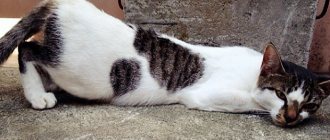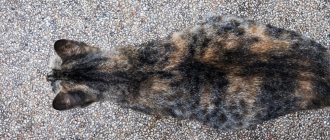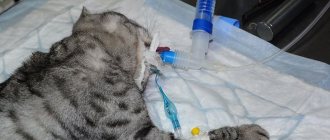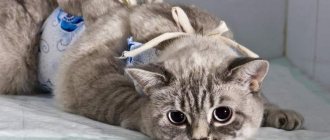Cats have a sexual cycle, which includes a period of estrus. At the same time, the animal experiences hormonal changes, due to which a change in behavior occurs - the pet becomes aggressive, restless and excitable, in addition, external signs of preparation for fertilization appear - secretion leaking out of the loop, swelling and redness of the external genitalia. If you do not plan to breed the animal, you can resort to sterilization, but not during estrus, but in the middle of the cycle. Sterilization during estrus is not recommended by experts.
Reasons for sterilization and appropriate age
Full puberty is achieved around the end of the first year of life. It is recommended to sterilize a cat before the first heat, at the age of 7-8 months and up to a year. Sometimes it is practiced to operate after the onset of puberty, but intervention during estrus is prohibited, since the risk of bleeding is high.
It is believed that early castration before the pet is six months old increases the risk of complications and also reduces the rate of growth and development of the animal. In general, the safe age for manipulation is from 7 months to 10 years. In adulthood, there is a high risk of postoperative complications.
The operation is chosen taking into account the cat's sexual cycle. Sterilization is carried out before estrus, since during the active phase and preparation for fertilization it can lead to hormonal disorders and other consequences.
There are several reasons to sterilize your cat, including:
- lack of desire to breed kittens;
- a pronounced change in the cat’s behavior during the period of estrus, when preparation for fertilization occurs;
- preventing an increase in the population of stray animals;
- the presence of contraindications to childbirth in a cat;
- priority over taking tablets to reduce sexual activity, since taking them increases the risk of complications and various diseases;
- prevention of pathologies that can develop as a result of prolonged abstinence from sexual intercourse.
Prohibited actions
Most online recommendations not only do not give the desired effect, but also pose a danger to the animal. Prohibited actions include the following:
- Using folk recipes. Valerian, popular among owners, is highly addictive among the cat family, and essential oils with a pungent odor can cause acute poisoning. Also, do not resort to recipes with iodine and soda. These substances lead to increased gas formation and vomiting.
- Cooling the genitals with ice water. At best, your pet will simply get scared, and at worst, it will develop inflammation.
- Frequent stroking. Try not to touch the area from the middle of the back to the base of the tail. After this, the cat crouches to the ground in anticipation of mating.
- Raising voices and physical punishment. Abuse will simply increase anxiety and rob your pet of your trust.
- Locking the animal in a dark room. The sun's rays do stimulate hormones, but a lack of them is harmful to physiological health and psyche.
- Taking sleeping pills. This is a very strong drug that is used to prepare for deep anesthesia. Due to the large number of contraindications and side effects, it can only be used as prescribed by a veterinarian.
- Imitation of sexual intercourse. Sticking thermometers, cotton swabs and other oblong objects into an animal is not only pointless, but also dangerous. The tool you use can cause infection or cause accidental injury.
- Mating with a neutered cat. Unlike the previous one, this method is not dangerous, but absolutely useless. If you do not want to pair your pet with a breed-class cat, then it is much easier and more reliable to simply sterilize her.
If your loved ones use any of the above, be sure to tell them about the possible consequences. In addition to such drastic solutions as sterilization, there are several other options that eliminate negative consequences.
Preparing for surgery
Preparing your cat for sterilization involves making sure she has enough water the night before surgery. You cannot feed your pet 10-12 hours before the procedure.
It is necessary to carry out a thorough examination of the cat by a specialist in advance and, if necessary, take tests. Transporting the animal should be done as comfortably as possible so that the cat does not experience severe stress. It is recommended to take a warm blanket or blanket with you to the clinic, as well as a well-absorbent bedding or special diapers.
Before the operation, the specialist re-examines the animal and, if there are no contraindications, proceeds with the manipulation. Identification of symptoms of intoxication - fever, elevated temperature, as well as some diseases is a reason to postpone the procedure.
How often and how long does sexual intercourse last?
The average frequency of estrus in pets is once a quarter, and its duration is 5-7 days. Deviation of these values up or down is acceptable, but only in the absence of diseases of the reproductive system.
If heat occurs every 3 weeks or once every six months, and its duration exceeds 3 weeks or lasts less than 5 days, consult a veterinarian. Your pet may need to be examined.
“
Females living outside are close to wild conditions. Therefore, they estrus occurs once every six months, and this is normal.
Sterilization before the first heat: laparoscopic and standard
The main purpose of sterilization is to eliminate the pet's ability to reproduce. There are several types of operations:
- Ovariectomy is the surgical removal of the ovaries. The operation leads to the cessation of hormone production and the impossibility of fertilizing the cat. This method is recommended for young pets with no history of childbirth.
- Ovariohysterectomy - removal of the uterus and its appendages. The operation can be performed on adult cats. This type of sterilization is also indicated for animals with various pathologies of the uterus and ovaries.
- Tubal ligation is a manipulation that prevents the possibility of fertilization without a hormonal shift; this operation is associated with a high risk of complications.
- Hysterectomy is the surgical removal of the uterus.
These types of operations can be performed in several ways - using standard abdominal surgery with access through the midline of the abdomen, a lateral incision, a small incision using a hook, and also using the laparoscopic method.
Technique
Standard abdominal surgery to remove the uterus and ovaries with access through the linea alba involves a fairly large incision of the skin and underlying tissue. However, such access creates favorable conditions for the specialist, as visibility increases. In this case, it is easier to notice the beginning of bleeding, as well as pathologies of internal organs.
The lateral approach is performed using an incision in the abdominal externus muscle. This method is characterized by less tissue trauma. A lateral incision is made to sterilize the animal if indicated. Most often, oophorectomy is performed through separation of the oblique muscles, since with this approach it is difficult to remove the uterus.
Abdominal surgeries are usually performed under general anesthesia. At the end of the procedure, the specialist sutures the wounds using special suture material. In modern clinics, it is possible to use absorbable threads.
There is a technique for removing the gonads, which involves making a very small incision in the abdominal wall, and the organ is removed using a special hook. This operation is regulated by unscrupulous clinics as a laparoscopic surgical method.
The laparoscopic method of sterilizing cats involves removing the genital organs through punctures in the abdominal wall using a special laparoscope device.
This operation is a minimally invasive surgical treatment. The specialist is armed with a special camera that is placed in the abdominal cavity, which significantly increases the surgeon’s field of vision.
Features of the rehabilitation period
The postoperative period during standard abdominal surgery depends on the individual characteristics of the animal, as well as the course of the surgical procedure. Typically, recovery takes about one week. During rehabilitation, it is necessary to wear a special bandage, as well as a collar; such measures prevent injury to the stitches and licking of wounds. Sutures are removed on average a week after the operation. If absorbable suture material is used, this procedure is not indicated.
Read more about how to care for a cat after sterilization.
Wound treatment is carried out using special antiseptic solutions. Chlorhexidine or Miramistin are most often prescribed. Treatment of sutures helps prevent the addition of a secondary bacterial infection.
It is recommended to carefully monitor the animal for a week or a week and a half to prevent jumping from great heights or injury as a result of a fight with another pet. It is also recommended to limit your pet’s contact with small children.
Diet therapy involves reducing the load on the digestive tract. Constipation should not be allowed to occur, as an increase in intra-abdominal pressure can lead to suture divergence. Therefore, it is recommended to enrich your cat’s diet with soft food and sufficient water.
The rehabilitation period after laparoscopic intervention is much easier. Its duration varies from several days to a week. Despite the low tissue trauma, it is still recommended to wear a bandage. During the recovery period, high physical activity is not allowed in the first two days. In the future, the cat can return to its usual lifestyle.
Reasons for refusal
In some cases, you should seriously think about the safety and feasibility of cat sterilization surgery.
- The procedure should not be performed if you have a disease of the blood coagulation system, since cutting soft tissues and removing organs increases the risk of bleeding. Massive blood loss is fatal.
- Immunodeficiency as a result of acute or chronic diseases can cause the death of a pet both on the operating table and during the rehabilitation period. The danger is associated with the possible addition of a secondary bacterial infection in the area of sutures and the site of organ removal. In this case, both local purulent inflammation and abscess formation of organs and sepsis may develop.
- Carrying out an operation to sterilize an animal during estrus can lead to various hormonal complications, as well as difficulties in removing the uterus, so it is more advisable to carry out the manipulation outside of estrus. There are no clear contraindications to removing the genitals and glands during this phase, but it is recommended to wait until the end of the period.
- Cardiac, renal, liver, and respiratory failure are contraindications for surgery.
1111
Possible risks
How to calm a cat - options during heat and when she's mad
If the veterinarian answers positively to the question whether it is possible to sterilize a cat during heat, he is obliged to explain to the owner all the possible risks:
- Significant enlargement of the uterus makes it difficult to remove it correctly from the animal’s body.
- Sterilization and estrus can greatly impact the immune system if the animal is initially weakened or has chronic diseases.
If the procedure is carried out during estrus, it can provoke an exacerbation of gynecological diseases in the cat.
Surgery during estrus is not advisable











